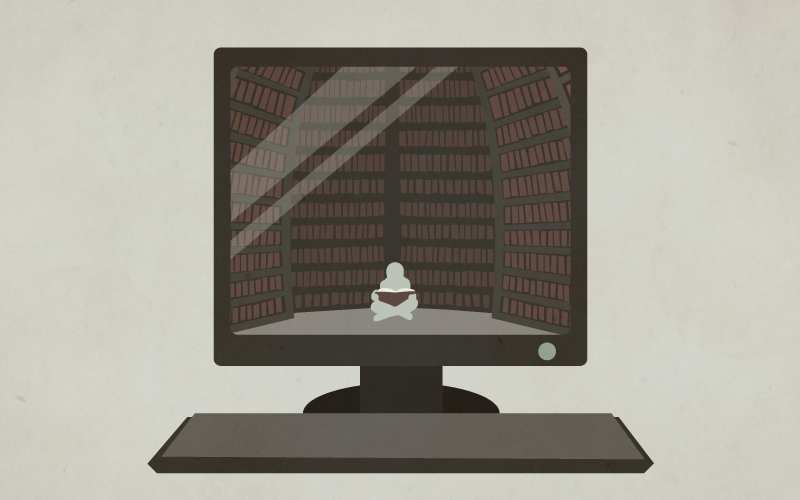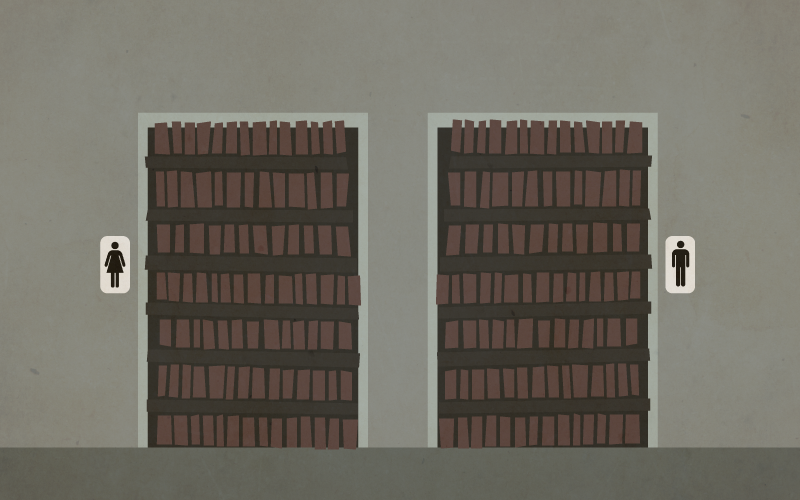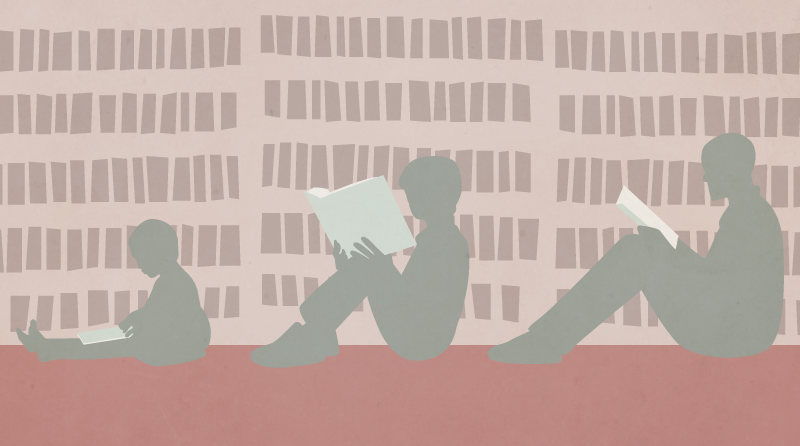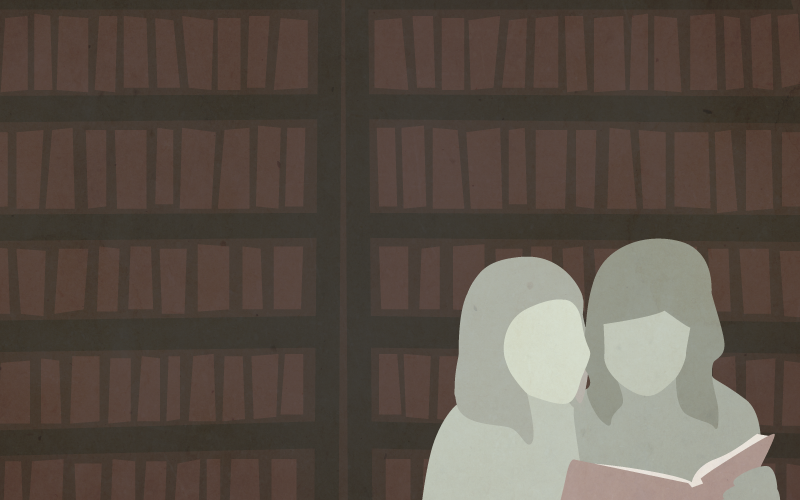If you ask Google Images what a library is, you’ll get a very clear answer: books on shelves in a column-faced building.
Like Google, most of us think of the library as a storehouse for books. We can be forgiven for thinking so. Our word library comes from the Latin librarium, meaning bookcase. It’s the same for the Latin and Greek equivalents for library — bibliotheca and bibliothiki, respectively — which led to the word for library in most modern Indo-European languages. It’s also notable that the Latin word for book, liber, originally referred to the kind of bark that was used in book construction. All this is to say that, through and through, we have conceptualized the library in terms of physical objects. Bark, books, shelves, buildings.
This being the case, we tend to paint libraries as havens for book lovers. Take, for example, the novel Kafka on the Shore, by Haruki Murakami, in which young Kafka Tamura runs away from home on his 15th birthday. Kafka is muscular and good-looking, but also introverted and bookish. As he says, “Ever since I was little I’ve loved to spend time in the reading rooms of libraries . . . Even on holidays that’s where you’d find me. I’d devour anything and everything — novels, biographies, histories, whatever was lying around. Once I’d gone through all the children’s books, I went on to the general stacks and books for adults.” Naturally, then, as a runaway, Kafka took refuge in a library. (Perhaps it’s worth noting that in Japanese, too, the word for library, toshokan, amounts to a building for books.)
If a library is just where a society keeps its books, then it’s easy to see why many people no longer perceive libraries as relevant. In the days of yore, a building full of books was a clear metaphor for collective knowledge. But today, knowledge is no longer bound to the printed page, and electronic and non-textual forms of media proliferate. Our cultural knowledge is no longer represented primarily as text within books. Moreover, with the internet, we can access our multimedia cultural knowledge from virtually anywhere.
It’s no secret that libraries are struggling. Funding is down in many public library systems across the country as the public no longer has much use for centralized storehouses of books. People say things like, “Why do we need libraries anymore when we’ve got Google?” Even the academic discipline dedicated to studying libraries seems to be backing away: A century ago, it was called library science; after World War II, it became better known as library and information science; over the past few decades, it’s been sloughing the L word (and often picking up words like computer and data). At my institution, for instance, the School of Library and Information Science was renamed to the College of Information Studies in 1985 — and today it’s the College of Computing and Informatics. Today, it houses a much wider range of degree programs than in previous decades, threatening to obfuscate the fact that the master’s of library and information science program is still one of the college’s core offerings.
But libraries are still important, and that’s because they are not fundamentally storehouses for books — despite the name and our longstanding cultural assumptions. We can begin to see this in the example of Kafka on the Shore, if we look beyond the surface. It’s not just that Kafka wound up in the library because he liked books. He wound up in the library because he had no other home, and the library provided a free, safe space. Indeed, over the course of the book, Kafka comes to know the proprietors of the library, and he ends up living there in a spare room. A library is not just a refuge for the intellect, but for the whole person.
As a culture, we seem reluctant to admit the breadth and depth of what libraries offer. For instance, last year I attended the play Spine, by Clare Brennan, which seeks to expose the unseen value of libraries. Following the show was a question-and-answer session with constituents from the theater company and the public library system. At one point in the conversation, a man in the audience scoffed at the idea that the library should provide bathrooms for homeless people. Libraries are about books!
We have undervalued the library all this time, I think, in part because we have overvalued the written word. Since our Judeo-Christian roots, we have ascribed mythic power to books. God Himself, it is said, is the Torah. And though popular culture has lost some of this mystical veneer since the Enlightenment, the fetishization of books has not abated: In the modern scientific tradition, we have come to consider knowledge to be only that which is communicable via text. But that is a terribly impoverished view of what human knowing can be.
Part of the reason for this is the way we conceptualize reading. We tend to think of books as things that hold information, and we think that when you read, the information jumps into your brain. If that were really how it worked, how could two people read the same text and get different information from it? It happens all the time, both in science and in life. Clearly there’s more to knowing than just getting information. As Emilio says in the novel The Sparrow, by Mary Doria Russell, reflecting on a failed mission to space, “We had all the information, really. It was all there. We just didn’t understand.”
In the age of print we have been held sway to what books can do and forgotten what they cannot do. To the extent that information from texts equates to knowledge, it is only knowledge-that, not knowledge-how or knowledge-of-what-it-is-like. For information to unfold as these ways of knowing, to lead to understanding, we must think of information as a process rather than a thing, and certainly not a process that is bound up in any particular object.
In Kafka on the Shore, there are many scenes where we find Kafka reading. As we experience reading along with Kafka, it is clearly not a simple matter of information transfer. Kafka’s reading material — The Arabian Nights is a favorite — stirs up meanings from Kafka’s past and future, and through reading he comes to better understand his present. Reading, then, is a process of transformation of a person with a past, present, and future through an experiential engagement with a book which also has a past, present, and future.
But even allowing for this evocative power of text, Kafka learns that the written word has its limitations. Towards the end of the novel, Kafka finds himself slipping back and forth between the world of literacy and the world of whole being. In trying to describe his experience, Kafka concludes: “Neither one of us can put it into words. Putting it into words will destroy any meaning . . . Words have no life in them.” We all know this, intuitively: Not everything can be put into words. But at the same time, as every poet knows, words can express more than they seem to say.
What is fundamental about the library is not that it holds objects, or even the nature of those objects, but rather how those objects are used. And though books are the first objects that come to mind, libraries hold far more than just books. To be sure, libraries also have objects like CDs, DVDs, magazines, newspapers, maps, artwork, electronic databases, computers, and printers. But they also offer things we’re less quick to identify as objects: space, relationships, trust, understanding, and opportunities. We must recognize that libraries speak to the whole person, not just the intellect.
When Kafka realizes this, the texture of the library changes for him. “The most important thing about life here,” a young woman tells him, “is that people let themselves be absorbed into things. As long as you do that, there won’t be any problems . . . It’s like when you’re in the forest, you become a seamless part of it. When you’re in the rain, you’re a part of the rain. When you’re in the morning, you’re a seamless part of the morning. When you’re with me, you become a part of me.”
What is a library? In the 21st century, more than ever, a library is a place that helps us realize that we are all part of each other. •
All images created by Shannon Sands.








